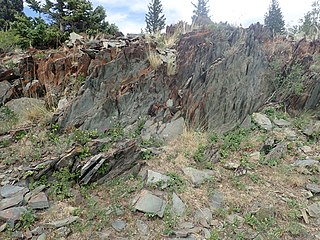
A pegmatite is an igneous rock showing a very coarse texture, with large interlocking crystals usually greater in size than 1 cm (0.4 in) and sometimes greater than 1 meter (3 ft). Most pegmatites are composed of quartz, feldspar, and mica, having a similar silicic composition to granite. However, rarer intermediate composition and mafic pegmatites are known.

The Cornubian batholith is a large mass of granite rock, formed about 280 million years ago, which lies beneath much of Cornwall and Devon in the south-western peninsula of Great Britain. The main exposed masses of granite are seen at Dartmoor, Bodmin Moor, St Austell, Carnmenellis, Land's End and the Isles of Scilly. The intrusion is associated with significant quantities of minerals particularly cassiterite, an ore of tin which has been mined since about 2000 BC. Other minerals include china clay and ores of copper, lead, zinc and tungsten.

The Vishnu Basement Rocks is the name recommended for all Early Proterozoic crystalline rocks exposed in the Grand Canyon region. They form the crystalline basement rocks that underlie the Bass Limestone of the Unkar Group of the Grand Canyon Supergroup and the Tapeats Sandstone of the Tonto Group. These basement rocks have also been called either the Vishnu Complex or Vishnu Metamorphic Complex. These Early Proterozoic crystalline rocks consist of metamorphic rocks that are collectively known as the Granite Gorge Metamorphic Suite; sections of the Vishnu Basement Rocks contain Early Paleoproterozoic granite, granitic pegmatite, aplite, and granodiorite that have intruded these metamorphic rocks, and also, intrusive Early Paleoproterozoic ultramafic rocks.

The Moppin Complex is a Precambrian geologic complex found in the Tusas Mountains of northern New Mexico. It has not been directly dated, but is thought to be Statherian based on a minimum age of 1.755 Gya from radiometric dating of magmatic intrusions.

The Maquinita Granodiorite is a Precambrian pluton that crops out in the northern Tusas Mountains of New Mexico. It has a radiometric age of 1.755 billion years, corresponding to the Statherian period.

The Vadito Group is a group of geologic formations that crops out in most of the Precambrian-cored uplifts of northern New Mexico. Detrital zircon geochronology and radiometric dating give a consistent age of 1700 Mya for the group, corresponding to the Statherian period.

The Big Rock Formation is a formation that crops out in the Tusas Mountains of northern New Mexico. Detrital zircon geochronology gives a maximum age for the formation of 1665 Mya, corresponding to the Statherian period.

The Burned Mountain Formation is a geologic formation that crops out in the Tusas Mountains of northern New Mexico. It has a U-Pb radiometric age of 1700 Mya, corresponding to the Statherian period.

The Harding Pegmatite Mine is a former adit mine that extracted lithium, tantalum, and beryllium from a Precambrian pegmatite sill. It ceased operations in 1958 and its owner, Arthur Montgomery, donated it to the University of New Mexico, which runs the site as an outdoor geology laboratory with mineral collecting permitted on a small scale.

The Ortega Formation is a geologic formation that crops out in most of the mountain ranges of northern New Mexico. Detrital zircon geochronology establishes a maximum age for the formation of 1690-1670 million years (Mya), in the Statherian period of the Precambrian.

The Rinconada Formation is a geologic formation that crops out in the Picuris Mountains of northern New Mexico. Detrital zircon geochronology establishes a maximum age for the Rinconada Formation of about 1723 Mya, placing it in the Statherian period of the Precambrian.

The Pilar Formation is a geologic formation that crops out in the Picuris Mountains of northern New Mexico. It has a radiometric age of 1488 ± 6 million years, corresponding to the Calymmian period.

The San Pedro quartz monzonite is a Paleoproterozoic pluton in New Mexico. It has a radiometric age of 1730 Mya, corresponding to the Statherian period.

The San Miguel gneiss is a Paleoproterozoic pluton in the Nacimiento Mountains of New Mexico. It has a radiometric age of 1.695 billion years, corresponding to the Statherian period.

The Joaquin quartz monzonite is a Mesoproterozoic pluton in northern New Mexico. Radiometric dating gives it an age of 1460 million years, corresponding to the Calymmian period.

The Ritito Conglomerate is a geologic formation in northern New Mexico dating to the Oligocene epoch.

The Uncompahgre Formation is a geologic formation in Colorado. Its radiometric age is between 1707 and 1704 Ma, corresponding to the Statherian period.

The Cibola gneiss is a pluton in central New Mexico. It has a radiometric age of 1653±16 Ma, corresponding to the Statherian period.

The Sandia granite is a pluton in central New Mexico. It has a radiometric age of 1453±12 Ma, corresponding to the Calymmian period.

The Los Pinos Formation is a geologic formation in northern New Mexico. It was deposited from the late Oligocene through the late Miocene epochs, based on radiometric ages of interbedded lava flows and overlying and underlying formations.























